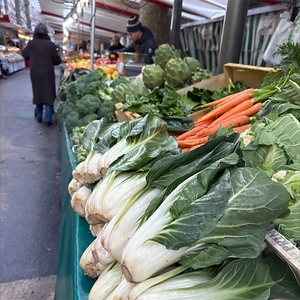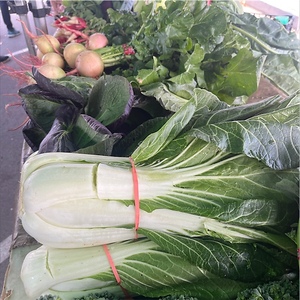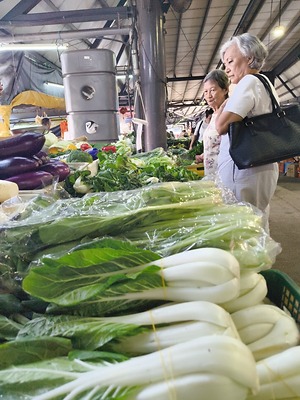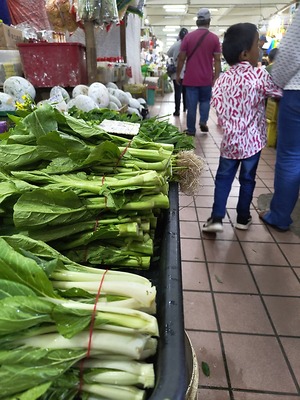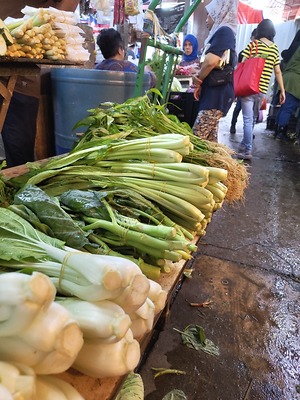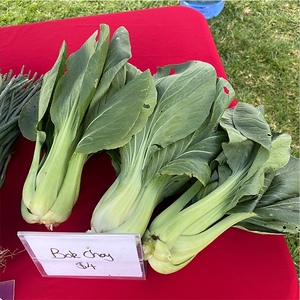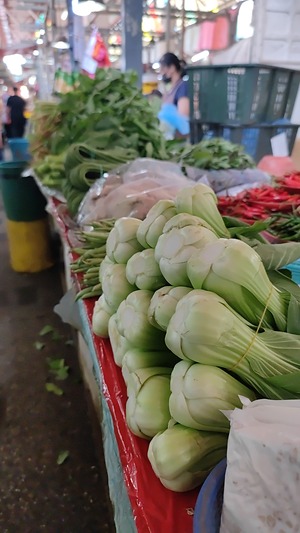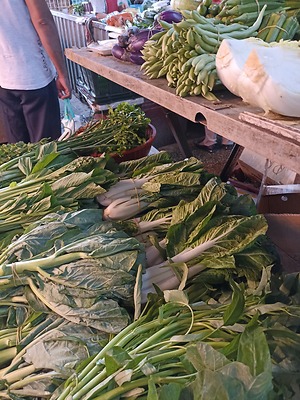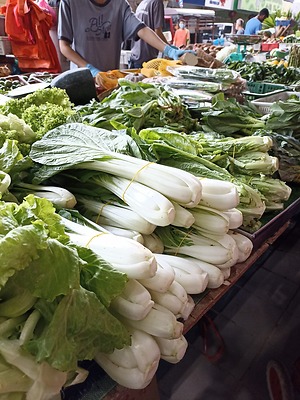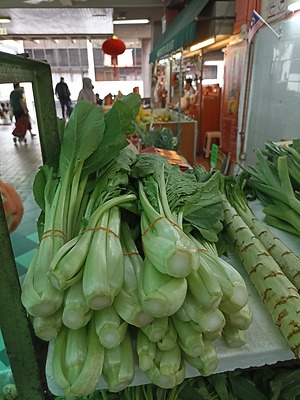


Bok Choy
Estimated Inventory, 30 lbs : 4.32
This item was last sold on : 07/16/25
Description/Taste
Bok Choy varies in size and appearance, depending on the specific variety, and averages 20 to 27 centimeters in length and 7 to 15 centimeters in diameter. Cultivars labeled Bok Choy are typically larger than baby types and comprise overlapping, loosely bunched stems connected to a central base. The stems are slightly curved and feature a lightly striated surface with a thick, firm, and wide nature. Mature Bok Choy stems are white and have a tougher, stringier, and firmer consistency than baby ones. Once cooked, the stems become crunchy, succulent, and lightly chewy. The leaves form along the tops of the stems and have a broad, flat, and pliable texture with a soft, crisp, and tender consistency. The oval leaves are dark green with some white veining. Bok Choy is edible raw or cooked, but is customarily cooked to create a milder flavor and tender texture. The stems and leaves have a refreshing, subtly grassy, green, and vegetal flavor with mineral-like undertones.
Seasons/Availability
Bok Choy is available year-round, with peak seasons in the early spring and fall.
Current Facts
Bok Choy, botanically classified as Brassica rapa var. chinensis, is a category of non-heading Chinese cabbage belonging to the Brassicaceae family. The herbaceous, leafy-stemmed plants were developed in China and are an ancient crop utilized for medicinal and culinary purposes. Bok Choy is the Cantonese name for the Chinese cabbage, while in Mandarin it is called Bai Cai. Both names roughly translate to “white vegetable.” Bok Choy is also known by other names worldwide, including Pak Choy, Pac Choi, and Spoon Cabbage in English-speaking regions, Chingensai in Japanese, Cai Be and Cai Chip in Vietnamese, Phak Gwangtung in Thai, Pechay in Filipino, and Cheonggyeongchae in Korean. In commercial markets, Bok Choy is a conventional vegetable sought by chefs and home cooks for hot and cold dishes. The stems and greens can be used raw or cooked, adding texture, flavor, and visual appeal to culinary recipes.
Nutritional Value
Bok Choy is a source of vitamins A, B, C, E, and K, which help strengthen the immune system, aid in wound healing, promote energy production, support healthy organs, and maintain overall bodily health. The greens also provide fiber to aid digestion and minerals like magnesium, potassium, iron, manganese, calcium, phosphorus, and copper. Magnesium assists in controlling daily nerve functions, potassium helps the body balance fluid levels, and iron develops the protein hemoglobin for oxygen transport through the bloodstream. Manganese protects brain health, calcium and phosphorus support bone and teeth health, and copper helps to produce red blood cells.
Applications
Bok Choy has a mild, green, and subtly mineral-like taste suited for fresh and cooked preparations. Young and tender greens can be eaten raw in salads and slaws or served as a crudité with dips. Most raw preparations call for baby bok choy. Mature, larger Bok Choy types are primarily cooked. It is recommended that Bok Choy stems be separated from the greens. The stems are typically blanched before cooking to soften their texture. Once prepped, Bok Choy is popularly stir-fried as a stand-alone dish or mixed with meat and vegetables. In Asia, it is common to add soy sauce, sesame oil, oyster sauce, or scallion oil to cooked Bok Choy for added flavoring. Bok Choy is also simmered into soups, stews, and curries or mixed into rice and noodle dishes. In China and Taiwan, the stems and leaves are minced and stuffed into dumplings. They are also braised, sautéed, or steamed with aromatics. Bok Choy has expanded worldwide and is being adapted into preparations like grilling in North America. Halving and grilling the greens develops a charred flavor to complement rich, meat-centric main dishes. Bok Choy is also pickled as a tangy addition to recipes. Bok Choy pairs well with aromatics such as scallions, ginger, and garlic, meats like poultry, beef, pork, and duck, tofu, sesame seeds, water chestnuts, bamboo shoots, carrots, and mushrooms. Whole, unwashed Bok Choy will keep for 3 to 5 days when wrapped in a damp towel and stored in the crisper drawer of the refrigerator.
Ethnic/Cultural Info
Bok Choy is often carved into jade as a household symbol of good luck and prosperity, used in Feng Shui. The Chinese pronunciation of Bok Choy sounds similar to the phrase “one hundred fortunes.” This homophone has made Bok Choy a favored item in carvings, amulets, and pictures. In Feng Shui, an ancient art of arranging objects and spaces in a harmonious and balanced way, Bok Choy is placed in the southeast part of the home, in the center of the home, near a window, or by the front door. There are many perspectives within Feng Shui, and the spot in the house is determined by the best qi, or natural energy flow. In Hong Kong, it is common to see Bok Choy decorative carvings made from green and white jade. These carvings are believed to welcome luck and wealth into the home, and the cabbage represents the element wood, one of the five essential elements within the foundations of Feng Shui. Bok Choy carvings are also occasionally seen at businesses, displayed with the “Three-Legged Toad,” also known as the Money Frog and Jin Chan, to attract wealth.
Geography/History
Bok Choy is native to China. Much of the history of the Chinese cabbage type is unknown, with scientists exploring possible origins within the Yangtze River Delta. It is believed that early Brassica species were introduced from Central Asia and the Eastern Mediterranean to China in ancient times, and after their naturalization, new types were created through selective breeding, including Bok Choy. It is thought that Bok Choy was widely cultivated in China by the 5th century and later spread to Korea in the 14th century and Southeast Asia around the 16th century. Bok Choy was also planted in Japan in the late 19th and 20th centuries. Historians hypothesize that Chinese immigrants carried Bok Choy to the United States in the 19th century, especially during the California Gold Rush. Today, Bok Choy has spread worldwide and has become a prevalent culinary ingredient for sale in fresh markets, wholesalers, and retailers.
Featured Restaurants
Restaurants currently purchasing this product as an ingredient for their menu.
| Georges at the Cove | San Diego CA | 858-454-4244 |
| Culinary Kitchen Catering and Events | Coronado CA | 619-798-8477 |
| Addison Del Mar | Del Mar CA | 858-350-7600 |
| The Remy | San Diego CA | 619-886-1358 |
| Juniper & Ivy | San Diego CA | 858-481-3666 |
| Duke's La Jolla | La Jolla CA | 858-454-1999 |
| La Costa Resort & Spa Main Kitchen | Carlsbad CA | 760-930-7063 |
| The Santaluz Club Inc - Banquet | San Diego CA | 858-759-3150 |
| Higher Grounds Coffee + Cafe | San Diego CA | 831-247-5395 |
| Shoreside Support Boat | San Diego CA | 704-277-7929 |
| UCSD Food & Nutrition Department Hillcrest | San Diego CA | 619-380-9840 |
| Huntress | San Diego CA | 619-955-5750 |
| Brigantine La Mesa | La Mesa CA | 619-465-1935 |
| Wrench and Rodent | Oceanside CA | 760-840-1976 |
| Ketch Grill and Taps | San Diego CA | 858-268-1030 |
| Lauberge Del Mar | Del Mar CA | 858-259-1515 |
| Reata Glen | Ladera Ranch CA | 949-545-2250 |
| C 2 C | San Diego CA | 619-972-9345 |
| Savory Moment (1) | Carlsbad CA | 619-633-8863 |
| Morning Glory | San Diego CA | 619-629-0302 |
| Viejas Casino Banquets | Alpine Ca | 619-295-3172 |
| Tribute Pizza | San Diego CA | 858-220-0030 |
| Pamplemousse Grill | Solana Beach CA | 858-792-9090 |
Recipe Ideas
Recipes that include Bok Choy. One
| Italian Recipe Book |
|
Foiled-Steamed Spicy Ginger Soy Cod and Bok Choy |
| Andrea Meyers |
|
Chicken Bok Choy |



